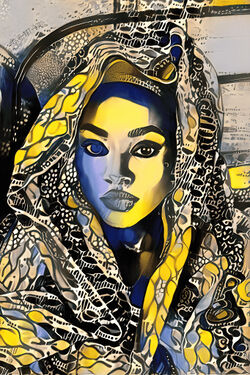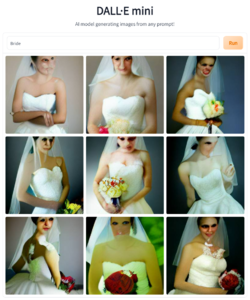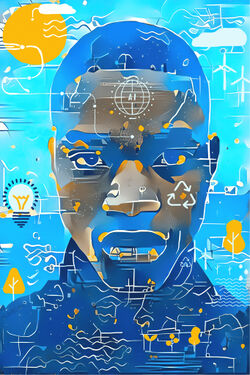September 29 2022 GM
| Glitter Meetups |
Glitter Meetup is the weekly town hall of the Internet Freedom community at the IFF Square on the IFF Mattermost, at 9am EDT / 1pm UTC. Do you need an invite? Learn how to get one here.
Date: Thursday, September 29nd
Time: 9am EDT / 1pm UTC
Who: Aishatu Gwadabe
Moderator: Mardiya
Where: On IFF Mattermost Square Channel.
- Don't have an account to the IFF Mattermost? you can request one following the directions here.
Quantum Visions of Africanfuturism: Allegories of AI
Explore how speculative narratives of Black imaginations can be read as allegories of living with data and artificial intelligence. Visual art pieces embedded with AI-developed patterns are in conversation with Africanfuturism, a term coined by writer Nnedi Okorafor, to prioritise the experiences, needs, and subjectivities of African communities on the continent and its diaspora.
To inspire reflection the conversation will tackle the following questions:
- What if AI was rooted in local knowledge systems rather than the cartesian model?
- How to preserve culture with exponential technologies?
Aishatu Gwadabe is a peace technologist, visual artist, and storyteller who advocates for social justice with AI and non-fungible tokens (NFTs). She is a creative diasporan of African descent who can be found on the list of the Lighthouse TOP 100 Brilliant and Inspiring Women in AI Ethics – 2022. Aishatu explores sub-Saharan African and indigenous epistemologies and ontologies found in folklore and oral literature for designing innovative, restorative, and equitable future(s).
Notes
Aishatuado Gwadabe is a peace technologist, visual artist, and storyteller who advocates for social justice with AI and non-fungible tokens (NFTs). She is a creative diasporan of African descent who can be found on the list of the Lighthouse TOP 100 Brilliant and Inspiring Women in AI Ethics – 2022. Aishatu explores sub-Saharan African and indigenous epistemologies and ontologies found in folklore and oral literature for designing innovative, restorative, and equitable future(s).
You can explore a virtual reality gallery that she created and is based on the vernacular design of the Hausa Kingdom. You can enter with your phone, desktop or VR glasses.
You can find her on the IFF Mattermost as @aishatu, on Linkedin and on Twitter
Can you share a little bit about your work and your goal with AI artistry and your goal?
- As a peace technologist, storyteller, and visual artist I focus on AI, web3, and NFTs for global peace.
- AI for conflict prediction
- AI for social justice
- AI for culture preservation
- AI for edutainment
- My goal is to spark reflection with my Art.
How do you use these technologies to create your artwork and what message or stories do you tell through your art?
- As an artist, I explore how speculative narratives of Black imaginations can be read as allegories of living with data and artificial intelligence. By combining deep learning techniques, digital art, and illustrations my artworks prioritize the experiences, needs, and subjectivities of African communities on the continent and its diaspora.
- Let me share an example with you:

- This is “Misclassified Bride”. It was part of an exhibition I did for the Mozilla Festival this year.
- Would a computer vision algorithm recognize the beautiful Northern Nigerian woman as a Bride? Or would it misclassify her as "people" and not even see her intersectional identity?
If AI is embedded in models that are biased are we able to truly use the existing ML algorithms to create the nuance you wish to show through your work?
- An AI would easily classify a white wedding dress as a 'wedding', but not the one wearing wedding attires from a different cultural context. AI applications systematically discriminate against specific populations. Biased decision-making is hardly unique to AI, but the growing scope of AI makes it particularly important to address, as human lives are at stake.
- Here I did an experiment with Dalle E mini and wrote the prompt "Bride"

- I have been mainly using AI to create patterns that I embedded in my illustrations. With AI art you can also create your own data set of images, photos or illustrations to develop something new.
- One has to be aware that while image generation models are doing impressive works, they may also reinforce already existing biases, especially when the models have been trained on unfiltered data from the Internet, images may contain stereotypes against minority groups.
- That's why I love using art to spark discussions about AI ethical issues because it can help demystify AI and people who have no knowledge about the issue can also actively discuss and reflect.
What are your thoughts about the ethics of NFTs, namely the environmental impact and that they don't don't even guarantee any money goes to the person who created the work?
- There have been many debates about web3.0 which is a version of the internet based on blockchain technology, a record-keeping system best known for facilitating cryptocurrency transactions.
- The attractiveness of Web 3.0 is that it is decentralized, meaning that rather than consumers accessing the internet through legacy platforms like Facebook, individuals, themselves, own and govern sections of the internet.
- Let me start with some of the worrying aspects of web3.0 in which NFTs are traded.
- In my experience, Web3.0 has provided platforms that enable participation and representation while at the same time allowing for community building.We can overcome these fundamental barriers by creating a community of creators, developers, and collectors. Now that we are free from legacy platforms that see us merely as consumers, we are empowered to shape the architecture of Web3.0 platforms and communities.
- However, I remain skeptical. The promise of Web 3.0 is to be inclusive and not to leave BIPOC communities behind. There is a need for more BIPOCs in power positions in Web 3.0 companies since we continue to have little say or stake in curating partnerships, facilitating campaigns, creating change for creatives, or developing culturally relevant projects.
- Speakers at Web3 conferences like NFT NYC, Bitcoin Conference, and SXSW are largely male and white.
- I am dedicated to preventing a dystopian vision of Web 3.0 that mirrors our current reality in Web 2.0, where historically marginalized groups already face disproportionate abuse on legacy platforms.
- As an AI ethicist, I research the effects of technology and I’m convinced that without a critical perspective focusing on diversity, equity and inclusion (DEI), familiar harms will not only be replicated; they will be exacerbated.
- The very pertinent question about the environmental impact is a timely question
- Non-fungible tokens (NFTs) may be harmful to the environment depending on how they are produced.
- Minting a single NFT using a proof-of-work blockchain uses the same amount of electricity as an average American household uses in 45 days.
- Yet there are also NFTs that use as much energy as a tweet
- Blockchain developers are working to find ways to lessen or eliminate the environmental impact NFTs have..
- But the same issue is with AI applications
To conclude
This artwork is called Green AI revolution. The aim is here to raise awareness about the necessity to develop GReen AI solutions. Training a single AI deep learning model emits as much carbon as five Teslas at the same time until their lifetime capacity is burned up. Over 629 tons of CO2!!! AI cannot help build a better future if it's not sustainable by design.
